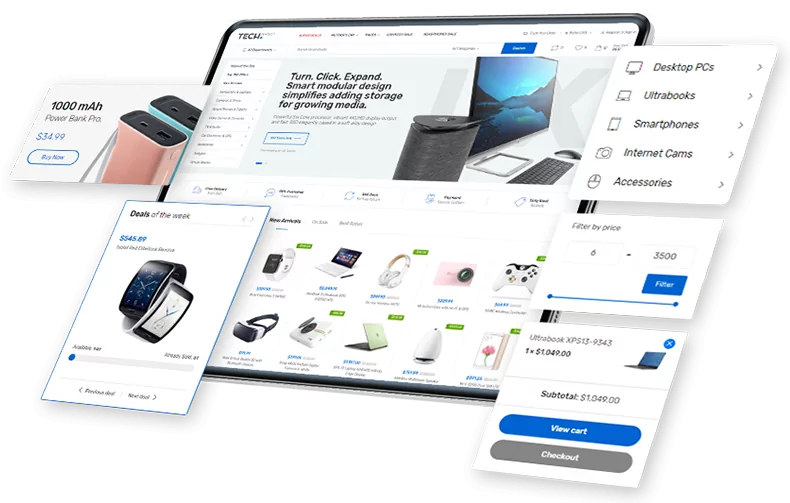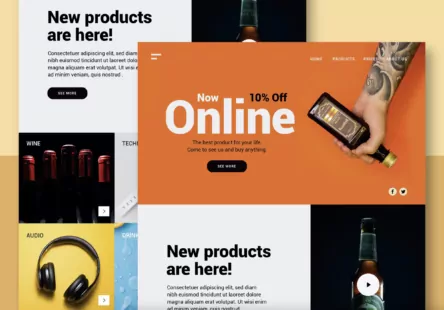Tabla de contenido
[zoomsounds id=”your-guide-to-designing-a-professional-online-store”]
Good e-stores are no longer the rare sight they once were. Quite the opposite, in fact. More and more businesses are taking to the internet. As the digital market becomes increasingly crowded, it’s important to stand out from the crowd.
There is no shortage of methods companies can use to garner the attention of consumers. Social media campaigns, search engine optimization, Google Ads, and much more. But gaining attention is one thing. To keep it, your store website must pull all the stops to establish itself as a household name.
How Professional Design Can Help Your E-Store – Some Tips
As we said, gaining viewers is just the first step in getting your business booming. But how do you then turn or “convert” browsers to buyers? And if you cannot do that, how can you make them recommend your store to others? The answer is simple: make an impactful first impression.
Simply designing a professional online store is enough to pique your visitors’ interest. This doesn’t just include making it look great (though we’ll discuss that too). It involves optimizing your site’s front-end for a peak interactive experience.
It’s difficult to pin down a website design that works for every single visitor. However, with the right approach, you can still provide viewers with a good enough platform to guarantee a competitive edge. The following are some of the ways you can do that.
1. Simple yet Sophisticated Design
It’s true that you shouldn’t judge a book by the cover. But that’s exactly what most online users do, and we cannot do much to change that. What you can do is opt for a professional online store design that is as visually striking as it is minimalist.
The use of quality content is an important part of your website’s layout, but you need to know how to use it well. Once you’ve chosen the ideal template for your site, strategically curate menus, use contrasting fonts, and be smart about your calls to action. Allow visitors to have a tour of your e-store as they decide what to buy.

2. Capitalize on Media
The use of visual media is a key component of online store design. For digital enterprises, it’s important to catch your viewers’ focus. Since you’re not writing a blog post, the text-based content must take a backseat while website graphics must gain the spotlight.
Images
For effective marketing, professional online stores and businesses employ a mixture of promotional imagery and pictures of their products. The best way to go about this is through clear, HD photographs placed tactically to provide visitors with as much information as possible with fewer text passages.
The use of high-quality files is a sign of a business that can be taken seriously and will most likely deliver in terms of service. But that’s not all.
When displaying products, you must allow visitors to check variations of each product with a single click, like clothes, hardware, makeup items, etc. Additionally, customers should be capable of sharing their own pictures of bought products to signal satisfaction or forward complaints.
Videos
Videos are also an effective promotional tool as far as visual media goes. Aside from promotional ads, videos can serve as part of a product’s supplementary information in professional online stores.
Quite often, people order items or gadgets without knowing how to operate or assemble them. This is often the case with DIY toolkits, cooking tools, and electronics. Adding videos of them being used allows consumers to be more confident in their purchases.
Alternatively, videos can help highlight the potential of certain goods as well. For example, if you’re running a stationery store, you can add videos of artists using your various tools or products to create artworks. Even if your customers aren’t as skilled as the person in that video, it still assures them that they are buying quality items from a competent seller.
Animations
Animated content makes for an engaging, interactive user experience. By integrating movements into your various features, you can take your online store design to a whole new level.
Ideally, however, it’s best not to overdo animations, as some sites do, for the sake of site performance, device compatibility, and maintaining an overall professional outlook.
3. Stand Out From The Crowd
If you don’t already have enough recognition to make yourself known as an e-commerce store, you’re facing an uphill battle. As more shops and stores take their business to the web, it’s hard for digital businesses to stand out on their own.
But with catch and memorable slogans and savvy marketing, you can slowly but surely become familiar as a reputable player. With the right team and management, professional online stores and e-businesses can come up with the perfect campaign to thrive in a saturated market environment.
On top of that, capitalizing on unique or helpful design features can also improve your customer ratings as well as your SEO prospects. These include search bars with category filters, custom orders, location-based currency exchange, user-oriented delivery, and a staff-friendly management model.
4. Payment Options – There’s No Wrong Answer
Whichever market you’re targeting, providing convenient payment means to your consumers is an area where you need to cover your bases.

People pay for goods and services online in a number of ways. Popular choices include electronic wallets (PayPal, Stripe, etc.), credit or debit cards, cash-on-delivery, digital receipts, and other transaction gateways.
Each method has its own pros and cons. For that reason, you cannot simply go with any one of them. An integral part of a user-oriented online shop or store design is to therefore incorporate as many payment gateways into your store as possible. This gives people an array of options based on personal preference or last-minute convenience.
5. Multi-Language Capabilities
With digital businesses, a major advantage is the ability to target audiences from various geopolitical backgrounds. But even though English remains the most used language on the internet, it is not the only one.
Professional online stores and businesses are pretty much obligated to promote inclusivity and diversity as part of their service. That includes giving international audiences, many of them either don’t speak English or use it as a second language, a more recognizable and familiar experience.
WordPress users have access to a wide range of plugins allowing them to design multilingual websites. This includes manual and automatic translations of content, along with currency conversions and in-depth interpretation of the text. Breaking language barriers is a surefire way to ensure that your store website is more accessible around the globe.
6. Social Networking
Even formal entities like businesses can benefit from a social media presence. If anything, that is a recommended marketing tactic to help present and endear yourself to a wider base of potential customers.
Sharing stories, live streams, announcing promotions, and new products through notifications are just a few of the possibilities e-stores get with social media platforms. Larger businesses can even promote goods and services through ads.

However, unlike casual users, professional online stores must use their online presence more suitably. Store owners themselves might not have the marketing skills to pull that off. And even if they do, who has the time to juggle running a business AND a Facebook profile or Instagram page?
A much better way is to hire your own third-party management team or specialist to help out. They can take the burden of effectively maintaining networking connections, optimizing content, and keeping up with trends off your shoulders.
7. Design That Values Your Users
When we discuss the issue of user experience on digital platforms, we don’t just mean cool features and pleasing graphics. User-friendliness has to do with long-term steps to make your website hassle-free for all users without discrimination.
There’s a lot that goes into providing optimum user-oriented site usage. For now, let’s just focus on the three main areas that most professional online stores need to focus on.
Mobile-First Design
This concerns a lot of what we’ve just covered, with the addition of one key bit of context. And that is the fact that, for online services, mobile-first design is the future. And that’s not just because of the idea that handheld devices offer a niftier avenue for online shopping.
Around the world, with each passing year, people are eschewing Desktop for Android or iPhones for consuming web content. From a business perspective, that is doubly important due to the fact that Google is now prioritizing mobile-friendly websites for indexing and SERP rankings.

Online Store that sells!
Do you need a redesign or a new website for selling online?
Complete solution for retail and wholesale. Great UX/UI designers, experienced programmers and high emphasis on testing. If you are looking for a professional partner for your business in the online world, contact us!
Unfortunately, many e-commerce sites are not mobile-oriented. Even the so-called “responsive” sites are, in fact, primarily for Desktop-first usage, which limits user experience on phones. It’s not just the smaller screens that affect site performance, but the limited bandwidth, space, and processing capabilities as well.
From a competitive point of view, mobile-first e-store design is non-negotiable in the current market. Businesses should make this a top priority for their websites. This includes optimizing content, website features, payment methods, and everything else for phone audiences.
Website Speed
Online shopping should not be time-consuming. Slow websites are much less desirable from a user perspective and enjoy much less traffic and user conversions with each second of delayed loading. As you lose visitors, Google loses interest in your site.
Maintaining website speed is important for all professional online store owners. The main steps to achieve that generally include compressing media files, caching, hosting solutions, and getting rid of unnecessary plugins.
Site Maintenance
Well-kept store websites are more likely to provide a more commendable service and user experience. Without maintenance, your store is in danger of providing slow service, dead links, outdated content, error pages, and other things that make for a poor public impression.
Website maintenance is a constant procedure aimed at making your site more accessible and welcoming for new and returning visitors. It helps make sure that
- Your software is up-to-date
- Your content is fresh
- The online store is compatible with all devices
- Quick handling of errors and fixes
- Junk files don’t slow your site

Why Use WordPress?
Selecting the right platform is a key step for integrating a professional outlook in online store design. While users can choose from any number of options, few are as roundly great a choice as WordPress. If you’re familiar with the internet as a whole, you probably already know that, given how many sites utilize it.
There are more than a few reasons why, in the world of professional web design and digital solutions, WordPress has become a household name. It allows developers and store owners to integrate an immense range of facilities for curating a professional online store.
On top of hundreds of beautiful themes, many of them free, online businesses get a thorough choice of supplementary software and add-ons for a wide variety of uses, from customizable features to improving user experience through multilingual, booking, speed-enhancing, and other plugins.
WooCommerce for Online Stores
A particular benefit that WordPress users have is access to the WooCommerce plugin for creating the professional online store of their dreams. A large portion of e-commerce sites currently use this tool and cannot seem to speak highly enough of it.
- WooCommerce facilitates the addition to your store of a number of features, like
- Seamless payment gateway integration
- Interactive site design and layout
- Geolocation and mapping services
- Managing inventory
- Customizable storefront
- Visitor dashboards and engagement
- Taxation support
- The mechanism for online orders
- Communication and notifications via email
WooCommerce is full of built-in features that allow store owners a great deal of flexibility and wiggle room when it comes to unique web designs made to benefit customers.
For ideal results, partnering with digital agencies (for lack of a better example, WeLoveWeb) is the perfect way for businesses to weaponize the facilities provided by WordPress and WooCommerce. This helps save time and invest valuable resources and capital in the advancement of the business and the welfare of clients.
Allow Others the Pleasure of Doing Business with You
Customer satisfaction is the primary objective of any business owner worth their salt. But as the market becomes ever more web-based and the competition gets tight, that becomes trickier. If you’re confident in your product, you need others to see what you’re offering through a skillfully and proficiently crafted outlook.
Fortunately, professional online store design offers a lasting and all-inclusive solution to help your store make a name for itself and find its footing in the digital realm. As long as you have a healthy following of gratified customers, your efforts will more than pay off in the long run.







